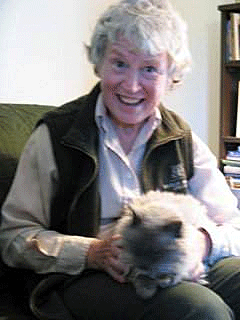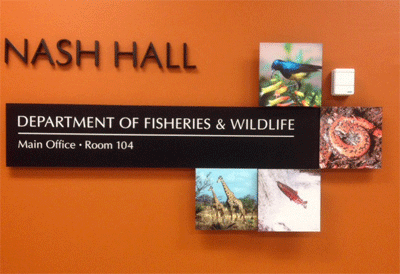
Homer Campbell Conservation Award
Recipient Biographies
2018 – Bob Altman
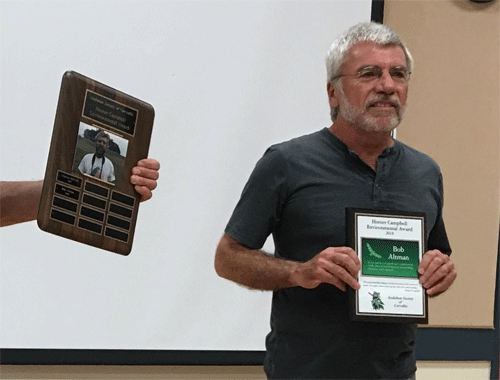
Bob Altman has worked for decades on the conservation of birds across the Pacific Northwest, with particular attention to species inhabiting grasslands and oak woodlands in western Oregon and Washington.
He was the first to spotlight the decline of Western Meadowlarks, Horned Larks, Vesper Sparrows, White-breasted Nuthatches, and Chipping Sparrows. He organized and conducted a survey of grassland bird species that is now a standard reference for researchers and conservationists working on these species.
He initiated and coordinated a large number of bird conservation projects, a few of these include: reintroduction of Western Bluebirds to the San Juan Islands; Lewis’s Woodpecker nestbox project; Black Swift waterfall nest survey from northern California to central Alaska; population survey of the local Slender-billed subspecies of White-breasted Nuthatch in oak woodlands of western Oregon; and Flammulated Owl conservation in the East Cascades and Ochoco Mountains region. His work, both research and advocacy, was a primary force behind the federal government’s decisions in 2001 to make the Streaked Horned Lark, a subspecies native to the Pacific Northwest, a candidate for listing under the Endangered Species Act (ESA) and in 2013 to list it as Threatened. He has continued work to revise the listing to Endangered, which would provide even greater protection for the lark. He has worked similarly for the Oregon Vesper Sparrow, crafting the recent petition by the American Bird Conservancy to list it as Endangered under the ESA. In the Corvallis area, he has worked with Greenbelt Land Trust and other organizations on the restoration of oak woodland and grassland habitat.
Bob has also brought together non-governmental organizations (NGOs) and government agencies to cooperate on conservation projects. For instance, he worked on Washington-Oregon Partners in Flight to enable cooperation between NGOs – including regional Audubon societies,
Oregon Field Ornithologists, and the Klamath Bird Observatory – and government agencies including US Fish and Wildlife, the US Forest Service, and both the Oregon and Washington Departments of Fish and Wildlife.
Bob has also worked proactively to engage landowners in conservation. Recently he contacted landowners and pushed for an initial biological assessment that led to a permanent conservation easement on a property in Lane County of 1200+ acres with high-quality oak savanna and woodland. This property hosts the largest known remaining population of Oregon Vesper Sparrows in the Willamette Valley.
He has also promoted birds and birdwatching to the public. For instance, his leadership helped launch the Oregon Cascades Birding Trail. This effort not only brought together conservation groups and regional tourism agencies to work toward sustainable ecotourism in Oregon, but also inspired the creation of a still-growing list of birding trails across the state.
For these reasons and others too numerous to list, the Audubon Society of Corvallis is honored to name Bob Altman as the recipient of the 2018 Homer Campbell Conservation Award.
2017 – Frances Stilwell
This year The ASC Board is pleased to announce that local botanist & artist, Frances Stilwell, was selected for this
award. She was presented with a personal plaque during the April 2017 General Meeting on April 20th, and her name was added to the perpetual plaque at Hesthavn Nature Center. ASC recognizes Stilwell’s unique contribution in creating, displaying, and publishing artwork illustrating Oregon’s Botanical Landscape: An Opportunity to Imagine Oregon before 1800. This book is a compilation of her art in pastels and watercolor of botanical landscapes in each of eight eco-regions of Oregon. The purpose of the book, in her words, was to share “how to educate ourselves about our natural world, to slow down and stop, to consider colors, shapes, and shadows.” Stilwell’s solo exhibit of 72 paintings in 2011 at the Benton County Historical Society and Museum’s Moreland Gallery became the basis for her book. The live exhibit, shown in venues around the state, was shown at the Columbia Pacific Heritage Museum in Ilwaco, Washington from May 12th to July 8th.
Creative people like Stilwell who use their gifts to portray the natural world and a sense of history are, in the broadest sense, environmental educators. Those who see her work, whether in live exhibit or book form, are given an unusual & alluring view of our historical habitat, and she has made her work widely available to the public.
Her advocacy for the natural world is based on her early background in science and fueled by a lifelong passion for conservation, expressed not only in her art but in frequent communications with public officials about state and local environmental issues. She is a longtime active member of the Native Plant Society and several arts societies. Those who see Stilwell’s vibrant & impressionistic work can be further inspired toward preserving the rich biodiversity we still have in our home state.
2016 – Warren and Laura Halsey
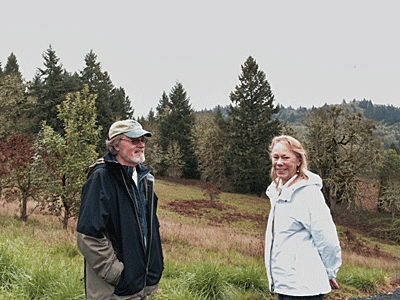
The 2016 recipients of the Homer Campbell Award have excelled in all criteria and made a significant contribution toward protecting Oregon’s precious wildlife: Laurie and Warren Halsey of Raindance Ranch. In 1992, the Halseys’ newly purchased 270-acre ranch, south of Corvallis near Alpine, contained much marginal farmland. As in so much of the Willamette Valley, the natural hydrology had been subverted to serve the dominant farming paradigm. Native plant species were eradicated in favor of Christmas trees, rye grass, and fescue monocultures.
To return much of the farm to wildlife habitat, the Halseys enlisted the help of agencies with programs and personnel dedicated to helping landowners: OR Dept. of Fish & Wildlife, Ducks Unlimited, US Fish & Wildlife Service/Partners for Fish & Wildlife, and the USDA Natural Resources Conservation Service/ Wetlands Reserve
Program. The first step was to restore the natural hydrology of 66 acres of the wetland areas associated with Muddy Creek. By 1997 ponds were reestablished along the creek; native forbs and grasses were planted; and other native wetland plant species came back on their own. In just one year, the number and diversity of bird species went from nearly zero in the monoculture grass habitat to 26 wetland-associated species. Thousands of birds were documented using newly restored ponds.
Now, nearly 30 years later, these wetland areas host native residents including red-legged frogs and western pond turtles, and serve as a stop-over for migrating waterfowl. More than 170 bird species use this restored habitat.
Over the years, riparian corridors, upland prairie and oak savanna habitats have all been nudged from remnants into prominence at Raindance Ranch. The Halseys re-introduced controlled burning (Native Americans in the valley traditionally burned large areas of the Willamette Valley each year to keep the land open for wildlife and edible plant species, like camas) on portions of the property – experimenting with different plant re-introduction regimes. Starting with local seeds, then transplanting rhizomes, they established dozens of milkweed clusters, some containing hundreds of plants, to aid the dwindling Monarch butterfly population, a milkweed obligate species. Kincaid’s lupine, planted for the Fender’s Blue butterfly, is also flourishing.
Benefits to the human community have been equally rich. The Halseys have generously let area school children and volunteer groups get involved with hands-on work, thereby giving folks, from pre-schoolers to retirees, a vivid learning
experience of just how fun helping wildlife can be. University students and independent professionals have carried out many research projects and surveys focusing on diverse subjects, such as the native honeybee, White-breasted Nuthatch, Wilson’s Snipe, and bullfrogs. Even international groups, hosted through OSU, have come to learn from the multi-faceted and ever evolving restoration projects.
The Halseys are quick to say they didn’t do much – everyone else did the work. But their vision for the land they so lovingly care for preceded and continues to direct the efforts that benefit so many wildlife species, right alongside the fields of rotating commercial crops.
While this award focuses on local contributions, it is worth noting that the Halseys are involved in a number of other habitat restoration projects on land they own elsewhere. Areas of the lower Sacramento River, Tule Lake/Klamath Refuges, and Yosemite National Park are also benefiting from their vision of enabling native plants and wildlife to thrive amid carefully managed human uses.
As Homer Campbell was fond of saying – “Wildlife need only three things: habitat, habitat, and habitat!” Today the Halsey’s ranch is a rich mosaic of diverse habitat: wetlands, upland prairie, oak savanna, managed cropland, and conifer forest. ASC is grateful to recognize the Halseys for their wonderful work on behalf of nature.
Note: Two documentaries featuring Raindance Ranch restorations were featured on OPB’s Oregon Field Guide: Monarchs
and Milkweed, 2016 and The Halseys’ Wildlife Habitat, 2001.
2015 – OSU Department of Fisheries and Wildlife
The 2015 recipient of the Homer Campbell Award is the Oregon State University Department of Fisheries and Wildlife. They have excelled in every criterion and, we believe, will continue to lead in work that helps protect Oregon’s precious wildlife. Members of the Department have played major roles in the preservation and protection of our wildlife and, as a consequence, of our ancient forests. Researchers in the Department provided initial and thorough studies of the Northern Spotted Owl and the Marbled Murrelet – studies that were pivotal to the understanding and protection of our old growth
ecosystems, as well as of the birds themselves. Other researchers studied the life cycles of rapidly declining populations of Band-tailed Pigeons and convinced the Oregon Department of Fish and Wildlife to change its hunting season to accommodate the birds’ extended breeding activities at mineral springs. That action led to the restoration of a newly vibrant population.
Another group of researchers dealt with a problem with Caspian Terns, whose coastal breeding populations had been eliminated by development. The terns had concentrated on a small island in the mouth of the Columbia River where they fed primarily on young salmon. Researchers successfully moved the colony to an island closer to the ocean where a wider range of prey is available, thereby lessening pressure on threatened salmon species. And they continued by establishing successful tern islands in the Warner Valley, at Summer Lake, and at Malheur NWR.
Yet another research group developed methods of tracking whales. The ability to follow the whales has led to an increasing knowledge of whales’ movements, habitat requirements, and susceptibility to environmental threats. Recently, studies by OSU researchers of the habitat requirements of Greater Sage Grouse led to the clearing of juniper in the Warner Mountains to provide more
suitable grouse habitat and may help the grouse escape being listed as an endangered species. Current research and applications of the department’s faculty cover a wide spectrum of activities aimed at the preservation of our wildlife. Faculty members are actively engaged in studying the effects of climate change on aquatic ecosystems, on avian populations, and on riparian ecology. Others study habitat restoration for salmon, terrestrial invertebrates in riparian zones, ecology of high desert streams, songbird ecology, seabird ecology … the list goes on!
In addition to the sheer volume and breadth of new scientific knowledge generated by the Department, the enthusiasm of faculty members to share on-going research with the community is high. ASC members and the public at large have benefited from many fascinating presentations at General Meetings through the years, made by both faculty and students in the Department.
ASC congratulates the OSU Department of Fisheries and Wildlife for the world-class biological research it continues to produce, much of it concerning our best loved local species and habitats. An accurate understanding of local ecology provides the solid base upon which to craft ways to conserve what is most precious.
2014 – Rana Foster
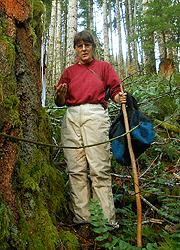
Our 2014 winner, Rana Foster, is an outstanding representative of the Homer Campbell Award qualities. A friend and fellow activist, Reed Wilson, says of Rana: “Rana’s strength is her persistence and irrepressible curiosity in investigating public lands timber sales. Where a concerned citizen might read the Environmental Assessment and submit comments, Rana will request the Silvicultural Report, the Biological Assessment, the Wildlife Report, the Soils Report, the Plant Surveys, and on. Rana will request reports that agency employees don’t even know exist until they search the warehouse. She will read these and pose questions for each, until the agency refuses to respond to her emails and restricts her to phone calls which they will not answer. She is incredibly perceptive in the forest, hears every bird, and sees every
plant or insect, not only sees them but how they interact, and with her creative mind, understands cause and effect better than most naturalists.”
Rana grew up in Oregon, Illinois ,and British Columbia and her parents gave their kids every opportunity to get outside and play, exploring on their own or going fishing or cross country skiing. Family trips between Oregon and Illinois always included stops at special places, such as Craters of the Moon, Pine Mountain, Steens Mountain, Fort Rock. Rana remembers an early archaeology class at Peavy Arboretum, where “it was a total eye opener to the science of anthropology and extra exciting for anyone young to find ancient and important things in dirt.” Her home in Illinois had a prairie meadow nearby, with a profusion of wildflowers, birds, butterflies and other insects.
Rana has an MS in Environmental Soil Science from OSU, a BS in Natural Science from Western Oregon University, an Associate of Science from LBCC and an Associate of Arts in the culinary arts management program from LBCC. Her Masters’ project was on using historic land survey data for present day landowners as a tool for restoration of native biodiversity and localized botanic ecology on Jackson-Frazier Creek.
The Audubon Society of Corvallis has benefitted greatly from Rana’s commitment to doing everything she can to help environmental
causes. She has transplanted many plants that would have been destroyed by development, placing many at the Hesthavn Nature Center, or other safe places. She has advocated for planting and distribution of showy milkweed to benefit monarch butterflies. She has been the Refreshment Chair for ASC and has helped arrange and staff public conservation events for ASC, such as the planting parties at Finley and special evening presentations. Rana has attended countless public meetings about conservation issues, often providing refreshments.
She has written letter after letter and submitted countless comments on timber sales and other conservation issues. She is an instrumental member of the Benton Forest Coalition, a group which promotes awareness of public lands by offering hikes and information on environmental concerns regarding state and federal forest land. Rana has been an Associate Director for the Benton Soil and Water Conservation District for many years. She has volunteered to search for red tree vole nests in federal forests and to find and measure legacy trees on our public lands, pending land use decisions.
As a tireless advocate for environmental causes and the protection of plants and animals, we are pleased to recognize Rana Foster as the 2014 recipient of the Homer Campbell Environmental Award.
2013 – Joel Geier

Joel Geier not only models significant contributions in the areas of environmental stewardship, awareness, and outreach in his own practices, but also shares his appreciation of the efforts and contributions of others with enthusiastic praise. He epitomizes good environmental leadership by example and encouragement. Known at
Corvallis Audubon for compiling monthly field notes for our CHAT newsletter for several years, Joel is more widely known around the state for participation and promotion of Christmas Bird Counts, and more so in helping develop and spread the use of a web-based open birding database, Bird Notes, for Oregon Field Ornithologists (now Oregon Birding Association)–well before Cornell University’s eBird. With the identification of Important Bird Areas nationally, Joel was instrumental in compiling Oregon ecoregion birding guides, most notably the Cascades and Willamette Valley Birding Trail guides. Locally he has worked on studies of valley grassland bird species, many in decline, like Western Meadowlark, Streaked Horned Lark, American Pipit, and Grasshopper Sparrow.
Joel extends his knowledge of birds and the habitat directly through classroom and field trips to refuges for Salem and Corvallis area charter schools, through local,
state and northwest birding and nature list-serves, and through public presentations. More than that, he works with E.E. Wilson State Wildlife Management Area, just beyond his front yard. Most notably Luckiamute State Natural Area has no greater advocate and volunteer, where he continues to lead many volunteer habitat restoration work parties.
Joel’s working knowledge of habitats helps him locate and work to protect many valley plant communities as well, through developing workable and realistic solutions with the landowner, be they individual or a public entity.
We congratulate Joel for his tireless work on behalf of Willamette Valley birds and habitat restoration, and for their conservation through education and leadership—thank you!
2012 – Don Boucher and Lisa Millbank

Don Boucher and Lisa Millbank are the winners of the Homer Campbell Environmental Award for 2012. They have both exemplified green living and have guided many people in appreciating and understanding the natural world. Both of them employ environmentally sustainable practices, both in their daily life and also in how they communicate this to others. They are never “preachy” but are always demonstrating how it’s possible to live happily without a car, commute by bicycle, work in the community gardens, enjoy and respect nature, and so on. Many of us wish that we could live up to their positive
example. Both of them show leadership on local environmental issues, again mostly by example. Through their organization Neighborhood Naturalist, they conduct nature walks for the public at which they point out interesting features — birds, plants, tracks, mammals, insects, scat, herps, and so on. They consistently encourage mid-valley residents to focus on the environment that is close to all of our back yards. In so doing, without being strident in any way, they give others the knowledge and sense of attachment that is so vital to environmental advocacy.
Also through Neighborhood Naturalist, they publish a seasonal newsletter that highlights an interesting plant, animal, or other organism, promoting education and exploration to all ages. The Neighborhood Naturalist web site also features photos, sounds, and videos they have made of local wildlife as well as educational materials for downloading.
Through Neighborhood Naturalist, they have been instrumental in making the first two years of the Corvallis Sustainability Coalition’s Natural Areas Celebration Week a resounding success. The Neighborhood Naturalist
program led many of the hikes during the celebration week and helped us introduce plants, animals and local natural areas to over 300 members of our community. In addition to the hikes, they also offered a showing of their movie, A Mid-Valley Safari, as well as a collection of high quality photos illustrating bird migration. They were instrumental in creating posters and fliers for the event.
Their Birding in the Willamette Valley and Birding By Ear classes offered through the Corvallis Environmental Center over many years have introduced many local residents to the natural world around us. When opportunities are posted to work on habitat restoration and preservation, Don and Lisa have shown up and worked hard, usually adding quite a bit to the event by sharing their knowledge with other volunteers.
Don and Lisa’s passion for the outdoors is obvious in how dedicated they are to sharing their knowledge with those around them. Their natural talent for observing, attracting and documenting wildlife is truly a gift that we are thankful they are so willing to share.
2011 – Steve Northway

Steve has worked tirelessly for decades to help restore native ecosystems in the Willamette Valley, Southern Oregon, and beyond. He has a vast working knowledge of regional, historic, and current native plant communities in Oregon. And he takes every opportunity to share his constantly expanding knowledge base. Landowners who want to restore their degraded lands to native biodiversity, such as Tyee Winery and Raindance Ranch, have found his expertise and enthusiasm vital to their efforts.
At Raindance Ranch Steve established a vibrantly healthy wetland area, complete with historically important Wapato plants, Sagittaria latifolia. He personally constructed several plots for Kincaid’s lupine, the threatened food plant for the
endangered Fender’s Blue butterfly. He also brought in other native plants, and encouraged the propagation and spread of species such as yellow violet (Viola praemorsa) and peacock larkspur (Delphinium pavonaceum), to diversify the restored oak savanna and prairie areas of the acreage.
Distributing the showy milkweed (Asclepius speciosa), exclusive food plant of Monarch butterfly larvae, is a passion with Steve – he is involved in on-going research regarding the plant’s specific soil needs. Steve is also widely educated in geology, chemistry and lepidopterology; as a committed conservation botanist, he has grown, developed and planted thousands of milkweed plants throughout the Valley. His unstinting work has bolstered Monarch habitat on this portion of the Monarch migration flyway.
Steve is active in an astonishing number of conservation organizations including the Native Plant Society of Oregon (Corvallis Chapter), Corvallis Environmental Center, The Orchid Society, Corvallis Tilth Organic Gardening Club, Cascadia Monarchs (co-founder), North American Butterfly Association, North American Truffling Society, and Peace Seeds of Corvallis. He has given workshops as diverse as “Fluorescing Marine Organisms” at Hatfield Marine Center to “Propagating Native Grassland Species.”
He led field trips to local, little known areas to show folks both rare and common native species when he was president of the Corvallis Native Plant Society. To the delight of anyone lucky enough to go on a field trip with Steve, he can identify most native Oregon species even when they’re not in flower, a measure of the depth of his botanical knowledge. Steve makes himself available for educational presentations to any interested group, like the Historic Cemetery Preservation Association. He very often gives away his own native plants at community gatherings.
As if all this weren’t a full time volunteer job, Steve participates regularly in public processes like the Philomath City Council and Benton County Habitat Conservation Plans, to make sure decision-makers are considering local and regional science-based conservation information. Steve Northway’s constant and numerous contributions to environmental conservation, awareness and outreach embody the letter and the spirit of the Homer Campbell Environmental Award. Please join us on April 21st when we present Steve with a personal plaque; his name will also be inscribed on the perpetual plaque displayed at Hesthavn Nature Center.
2010 – Jeff Mitchell

Audubon Society of Corvallis is pleased to recognize Jeff Mitchell of Corvallis as the 2010 recipient of the Homer Campbell Environmental Award. In his work as a science teacher at Philomath High School, and previously in Eddyville, Jeff has been a leader in the “No Child Left Inside” movement. A key part of his curriculum involves getting students out of the classroom and into real-life learning situations. He has been instrumental in mentoring and motivating other teachers to do the same. Jeff embodies the philosophy of this movement which states that exposing students to the natural world, and making it a valuable part of their lives, gives them a personal stake in its protection.
Jeff has an outstanding ability to form creative partnerships among diverse aspects of the community in order to provide interesting environmental learning projects for his students. For instance, his ecology students conducted original research on a population of freshwater mussels in the Willamette River. After rafting to the site, they collected, measured, and returned to the river over 1200 specimens. When they analyzed their data they found that no mussels were shorter than 5 cm. Given the life history of mussels, they concluded that the native mussels ceased reproducing about 40 years ago when their host fish population crashed due to poor water
quality and dam construction that blocked access to spawning habitat in the headwaters. Mussels also have to compete with an invasive clam from Asia for food and space.In another on-going project, students engage in many restoration activities, particularly along Newton Creek and other Marys River tributaries. His students work with Marys River Watershed Council to monitor water temperatures, oxygen content, and turbidity. Several of these tributaries are now much more salmon-friendly as a result of tree planting and other enhancement activities conducted by Jeff and his students. For the past decade, Jeff has been taking his classes to study plant and animal ecology in the abandoned mill ponds that were once part of the Clemens Mill just east of Philomath. His students maintain a fleet of 30 bicycles to visit the site half a mile from the school, obviating the need for the expense and carbon expenditure of school buses. In the Spring, students share what they have learned with Philomath and Corvallis middle school students at Stewardship Field Days.
In partnership with the Fresh Water Trust and Mary’s River Watershed Council, high school students facilitate at 12 learning stations that feature scientific inquiry activities. Topics range from ethnobotany; wetland soils; reptile, amphibian and mammal surveying and ecology; bio-control of invasive plants; and site history to canoeing and log scaling engage the kids in an all day outing. Also at the mill ponds, students planned and built an 8’ x 24’ wildlife study blind, funded by a grant from Benton County Soil and Water Conservation District. The blind overlooks North Pond and is used by hundreds of students to collect data on Western Pond Turtles and migrating waterfowl.
Students planned and planted four riparian restoration projects or private landowners and the City of Philomath. They recently removed beaver protection cages from 50-foot cottonwoods, alders, maples, and seven other species that were planted ten years ago. Students also planned and planted mitigation wetlands for the City, Gene Tools, and Georgia-Pacific Corp. In a ten-year partnership with Shoulder to Shoulder and Gathering Together Farms, Jeff’s botany students grow and evaluate 20 varieties of organic
gourmet lettuce in variety trial experiments. Seed germination rates, flavor, appearance preferences, pest resistance and winter hardiness are all evaluated. Students graph results and make recommendations to the farms in professional research papers. Jeff says students take their jobs seriously, learn to design and carry out experiments, and become passionate salad eaters, while farms get educated input on the public’s perception of the lettuce varieties. Botany students have also planned, fenced, and planted a 30-tree mixed fruit orchard for the Philomath Food Bank. They chose trees for resistance to pests and local diseases. The orchard also serves as a pruning lab for the students.
Jeff’s experiences at the old mill site made him appreciate the value of the site as an outdoor classroom located conveniently close to Philomath schools. So he became involved in the Mary’s Peak Natural Resources Interpretive Center and provided vision to that group to work toward acquiring the site for conservation and outdoor education. For the past five years Jeff has organized an exciting summer science campfire program at the site, called “Science, Music and Marshmallows” that combines education, entertainment, and family fun. This popular event attracts about 100 people each week in August. Jeff Mitchell has invested a major part of his life in providing motivation and training to the naturalists and scientists and conservationists of the next generation. His outdoor programs have brought communities with differing political philosophies together by focus- sing on the science.
Thanks to his vision and hard work, our natural areas will be valued and protected by those young people he has inspired. With typical humility, Jeff says, “All I do is give the students opportunities to do relevant work in the community by networking with private businesses, individuals, non-profits ,and government agencies who have needs. I have found that our high school kids are a valuable resource, as they can apply their knowledge to important on-the-ground projects in our community that otherwise might not get.”
2009 – Elsie Eltzroth
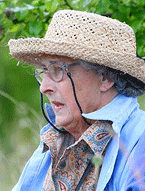
Elsie Eltzroth began her decades-long volunteer project in the central Willamette Valley in 1976 at approximately the same time that Hubert Prescott started a similar bluebird nest-box program in the northern Willamette Valley. The Western Bluebird was on the Audubon “blue list,” with only 6 known nesting pairs in Benton County in 1977 and only 7 the following year. Under the tutelage of Lloyda Thompson-Crowley, Elsie learned to band bluebirds and report data, collaborating with Oregon State University biologists to observe and document behavioral and physiological differences between the Western Bluebird and other bluebird species. She documented every observation, including intra- and interspecies interactions, habitat and weather changes, breeding and social behavior, patterns of geographical movement, and causes of morbidity and mortality. Elsie was insatiably curious and indefatigable in her mission to boost the population of this once-common songbird of the western states.
Bringing back the Western Bluebird became her passion and her full time vocation. Elsie and her husband had previously worked at rehabilitating injured and ill raptors and other birds. Elsie turned this expertise toward the bluebird, as each bluebird life was vital to the recovery of the species at that time. She became adept at the processes of necropsy and study skin production. As she reached out to local and regional landowners and organizations, Elsie became known as “the Bluebird Lady.”
As a charter member and with full support of the Audubon Society of Corvallis, she used her knowledge for public education, interfacing with countless organizations such as other conservation groups, school classes, Boy Scouts, and gardening clubs, inspiring them to mobilize their resources to contribute to the conservation of the Western Bluebird and other native cavity nesters. With study skins, eggs, mealworms, and educational literature in hand, she staffed booths at many public events, passing her knowledge on to thousands of individuals over the years. She served as a board member of the North American Bluebird Society and charter member of the Oregon Field Ornithologists.
In the late 1980s and early 1990s, the data and anecdotal information compiled by Elsie became nationally recognized for its value to the scientific community. Both singly and in collaboration with other authors, Elsie’s work was published in a number of journals, from Bluebird Society newsletters to peer-reviewed ornithological
works (including Avian Diseases (1979, 2001), Birds of Oregon – A General Reference (2003), The Birds of North America (The Western Bluebird Monograph) No. 510, 2000, Sialia, and Connie Troops’ Bluebirds Forever. Since then, Elsie was been regarded as one of the leading experts on the Western Bluebird. Her trail and her work have been referenced in many publications.
In May 2009, Elsie was honored by the Audubon Society of Corvallis with the Homer Campbell Award. This is an annual award that recognizes local individuals or organizations who have made significant contributions in the areas of environmental stewardship, awareness and outreach. In October 2009, Elsie was featured on an episode of Oregon Public Broadcasting’s television program Oregon Field Guide titled “The Bluebird Lady.”
In summary, Elsie was an immense inspiration to lovers of songbirds. Under the banner of the Audubon Society of Corvallis, she established and maintained associations and collaborative efforts with local, regional, and national groups and government entities. With untiring action and perspective, she devoted her life to the study and conservation of a beautiful and charming bird that was once quite common in the Willamette Valley, and she made a difference.
2008 – Bill & Carla Chambers, Stahlbush Island Farms

Corvallis Audubon is pleased to recognize Bill and Karla Chambers, owners and operators of Stahlbush Island Farms, as this year’s recipients of the Homer Campbell Award. The award is given annually, in memory of one of our most beloved former leaders, to recognize local
contributions to conservation or environmental education. For the second year in a row, Audubon is honoring local farmers. However, last year’s award, to Wally and Mary Eichler, was made primarily for wildlife habitat creation and conservation on their farm. The 2008 award to Bill and Karla is made primarily for the responsible stewardship of their farmland through sustainable agricultural practices.
Bill and Karla have owned the 4000-acre Stahlbush Island Farms since 1985. Since then they have transformed the farm to fulfill their vision of environmentally friendly, sustainable agriculture. Some of the practices that they have either adopted or pioneered include the following: (1) Rotating crops annually to break insect and disease cycles, control weeds, and reduce or eliminate pesticide use; (2) Strip tilling, to save fuel, improve soil quality, and control weeds; (3) Growing cover crops to enrich soil organic matter, replenish soil nitrogen, and reduce soil erosion; (4) Maximizing recycling and composting practices; (5) Eliminating herbicides, fungicides, and insecticides for many of their crops and using minimal amounts of organic products, when necessary, on the rest; (5) Pioneering no-till drilling, a technique that minimizes release of soil
carbon dioxide to the atmosphere while improving water-use efficiency and increasing plant growth; (6) Rigorous testing byindependent laboratories of soil and product samples for chemical residues. In addition they work extensively with OSU agricultural specialists to learn how nitrogenous compounds move through soil and how this can be controlled to eliminate leaching of nitrogen into ground water. Bill and Karla have promoted their practices throughout the agricultural community.
We are far from the first to honor Bill and Karla for their achievements in sustainable agriculture. Previous recognition of Stahlbush Island Farms has come from (among others) Oregon Department of Environmental Quality, The Food Alliance, AGRI-Business Council of Oregon, KEZI ABC Channel 9, Oregon Department of Energy, and Sustainable Northwest. The Homer Campbell Award consists of a plaque and inscription of the awardees’ names in the perpetual award record, which is on permanent display at Hesthavn.
2007 – Wally & Mary Eichler
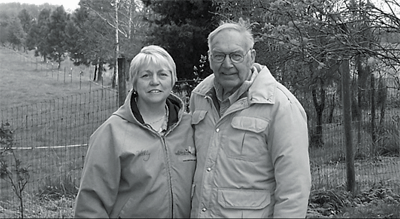
The annual Homer Campbell Award honors a person in our region for outstanding contributions to environmental protection and for stimulating increased public awareness of conservation issues. For the 2007 award, the third to
be conferred, Corvallis Audubon has selected Wally and Mary Eichler, in recognition of their many contributions to environmental stewardship.
Both Wally and Mary were licensed rehabilitators for many years, and Mary served for some time as the Corvallis animal control officer. Later she was elected to the Benton County Soil and Water Conservation District, where she played key roles in flood plain management and development of the Jackson-Frazier Wetland.
The Eichlers live on a small farm near Sequoia Creek in northeast Corvallis. Their management of this property has set an example that inspires all who know them. They have planted numerous native plants and shrubs, fenced the slough to keep cattle away, and planted trees and erected nesting boxes to attract barn owls, ospreys,
and numerous song birds. The resultant diversity of bird life on this property testifies to the impact that individuals can make in managing their own property, and it has made the Eichler farm a regular stop for the ASC Christmas Bird Count.
For many years the Eichlers ran a company in Linn County that created alternative uses for straw residue from grass seed production, designed to minimize field burning. In the words of one nominator, “Of all their diverse activities I think this enterprise has really made an impact on the air quality here where we all live and enjoy the good life.” Please join us on May 17, as we gather to recognize the contributions of this remarkable couple.
2006 – Bob & Liz Frenkel
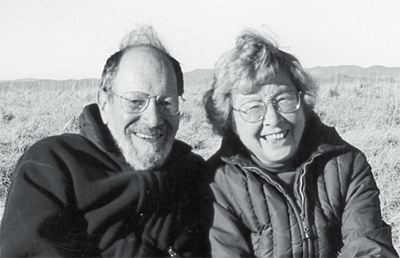
For the 2006 Homer Campbell Award, the second to be conferred, Corvallis Audubon has selected Liz and Bob Frenkel, a remarkably tenacious and effective couple. Liz and Bob have each made great personal contributions to the extent that either one would be an excellent individual recipient. However, their individual efforts reinforce each other, and because both are so fully committed they are often thought of as a particularly formidable unit: Liz-and-Bob, happy warriors in support of conservation.
The Frenkels moved to Corvallis in 1965, when Bob, a professional wetlands ecologist, joined the OSU faculty. He retired in 1991 as Professor of Geosciences. Both before and after his retirement, Bob and Liz were both committed activists on behalf of the environment. Although Bob has worked on wetland preservation in several areas, including the Salmon River estuary, the Willamette River Greenway, and the Owens Farm, he is best known for his efforts on behalf of the Jackson-Frazier Wetland. He began working in the 1970s to preserve this 144-acre urban “wild island.” His contributions included fundraising, personal financial contributions, service on planning commissions, and securing the thousands of hours of volunteer effort needed to complete the 3400-foot raised boardwalk through the wetland, which in 2005 was officially named the Bob Frenkel Boardwalk by the Benton County commissioners.
Liz has worked tirelessly as an environmental activist, primarily through the League of Women Voters and the Sierra Club. In 1995 she was described in a Sierra Club listing of “Earth Day Heroes” as “a doggedly tenacious powerhouse who thinks nothing of racking up $300 home phone bills for the environmental cause.” Her local
positions, all volunteer, have included Legislative Coordinator for the Oregon Sierra Club Chapter, Natural Resources Action Coordinator of the Oregon League of Women Voters Action Committee, and member of the Benton County Comprehensive Plan Revision Steering Committee.
More recently she has joined forces with the National Sierra Club, as a member of the Smart Energy Futures Conservation Initiative Committee. In these positions she has spent thousands of hours lobbying and testifying before the Oregon Legislature and other governing bodies, earning a reputation as one who knows both land-use planning and how to push the levers of government to make things happen. In recent years she has fought to defend funding for State Parks, to defeat State Initiative 37, to block dam construction on the Upper Klamath River, and to open our Legislature to more public scrutiny. One elected official described her contributions as follows. “Oregon’s beauty feeds the soul and strengthens people for meeting the challenges in our lives. Liz Frenkel has spent a good part of her life ensuring that this part of the world continues to be healthy for its creatures one and all.”
2005 – Elzy Eltzroth

Elzy Eltzroth was presented with the first ASC Homer Campbell Environmental Award. Another plaque with his named engraved on it will be placed at Hesthavn. This other plaque has blank spaces available for future recipients. What follows here is Elzy’s speech from the night of the award:
“It was a great surprise and a great honor to be selected for the ASC Homer Campbell Environmental Award. It never occurred to me that I was eligible, let alone qualified. I was just trying to protect the birds. Growing up in the Depression, we learned early that Conservation
101 was a way of life. We weren’t more than a half-step removed from hunter/gatherers. Women canned all the food they could get their hands on from garden plots, orchards, and forests.
We enjoyed fishing as a family sport and ate everything we brought home, from carp and eels to suckers—we’re talking about the Ohio River in the thirties. Even groundhogs, possums, and clean roadkills, whenever we lucked upon one, went into the skillet. But we drew the line at amphibians, house pets, reptiles and skunks. Most anything fried brown in bacon grease was better than nothing. I remember one of Mother’s favorite sayings was, “Waste not, want not.” She often urged us to “Eat it up, wear it out, make it do, or do without.” This resonates in me to this day.
Birding didn’t come into our lives until the midsixties. We’d belonged to few, if any, organizations, and by the time we arrived in Corvallis it seemed like National Audubon Society might be something we should try. We joined ASC in November 1971, two months after the first regularly scheduled meeting, and found kindred spirits. The chapter had its growing pains, of course, but those are stories for another time.
Expansion and experience brought a lot of good players to the field. Steve Elefant, who chaired the Conservation Committee, was one of those. Starting around the mid-eighties, some real heavy hitters stepped forward: Jim
Fairchild, Homer Campbell, Inge King, Tom Gilg, Mary Van Brocklin, Dave Mellinger, then Jim Fairchild again—all of whom got many good things accomplished—and that’s just speaking of the Conservation Committee. On the back of our newsletter and of most newsletters for the past three decades you can find names of those who have done and are still doing important work in other ways. Homer Campbell said it so well: “We understand that habitat is the key to survival of all creatures in nature. Our goals, actions and programs reflect this understanding.” Isn’t there a lot of Homer Campbell in all of us here? Franz Dolp, a former OSU professor, wrote, “I find a litany of reasons to preserve and care for the natural world. My survival depends on it. I breathe its air, drink its water, eat from its table. It provides an endless reservoir of possibilities for my contemplation. It brings its sounds to my ears, its glory to my eyes. It is, for me, the ultimate context to explore my own spirituality as a human being.”
I don’t think it could be said any better. There is a lot of Franz Dolp’s creed in me. Thank you for the things you have done for Audubon. To paraphrase Steve Dominguez, and others: “If there were more people like you, the world would be a better place.” Thank you wholeheartedly for the honor you have bestowed on me.”
-Elzy (Merlin) Eltzroth






